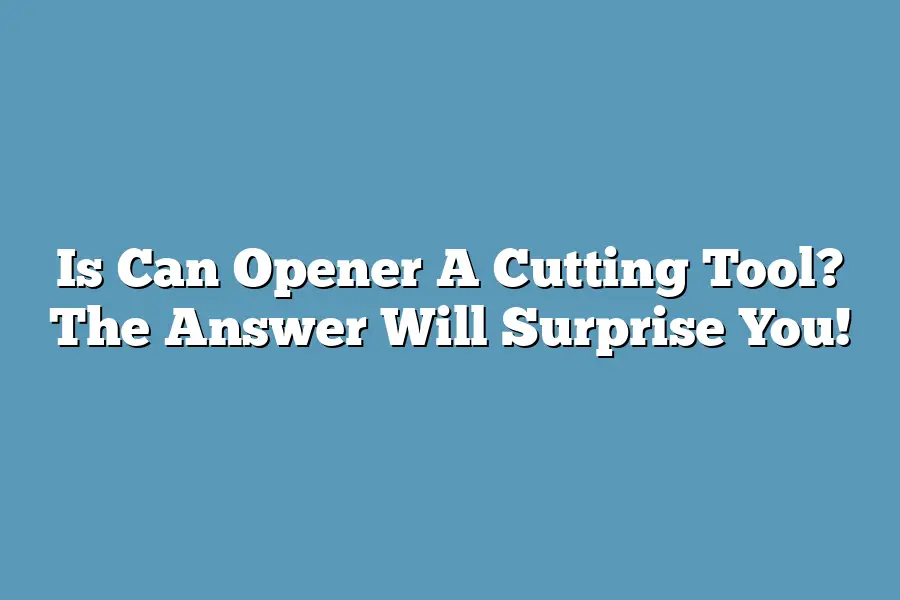No, a can opener is not a cutting tool. A can opener is a device used to open metal cans by puncturing and tearing off the top, but it does not involve cutting in the classical sense. Instead, it uses a combination of twisting and piercing motions to access the contents of the can. While it may seem like a cutting action, it’s a distinct type of tool that serves a specific purpose.
I’ve spent years slicing through the noise to get to the heart of what matters – and when it comes to can openers, I’m not just talking about any ordinary tool.
The answer lies in whether a can opener is truly a cutting tool, or if it’s just cleverly designed to make our lives easier without actually doing the heavy lifting (or cutting).
As someone who’s always been fascinated by the anatomy of everyday objects, I set out on a mission to uncover the surprising truth behind these humble devices.
From manual to electric, and from ancient history to modern innovations, I’ve peeled back the layers to reveal the fascinating story of can openers – and what you’ll discover will blow your mind!
Table of Contents
The Anatomy of a Can Opener
When it comes to can openers, most people assume they’re just simple cutting tools.
But are they really?
I’m here to reveal the surprising truth about these humble devices.
Let’s take a closer look at the anatomy of a typical can opener – manual or electric.
At first glance, you might think a can opener is all about the cutting edge (pun intended).
But, surprisingly, most of its components have nothing to do with actual cutting!
Instead, they’re designed to work together in harmony to puncture and remove the lid from a can.
So, let’s break it down.
A manual can opener typically features gears, handles, and lids – all non-cutting features that might seem unrelated to the task at hand.
But don’t be fooled; these components are crucial to the process.
The gears, for instance, provide the necessary mechanical advantage to amplify the force applied by the user.
This allows you to apply less physical effort while still achieving the desired result.
The handle, meanwhile, serves as a comfortable grip for your hand, making it easier to apply the necessary force and maintain control throughout the opening process.
And let’s not forget about the lid – it’s designed specifically to fit snugly around the base of the can, providing a secure platform for the gears and other moving parts.
Now, let’s take a look at electric can openers.
On the surface, they might seem like they’re all about cutting-edge (again, pun intended) technology.
But again, most of their components are focused on non-cutting features.
For example, an electric model employs a spinning blade that doesn’t actually cut the metal – it’s designed to pierce the top of the can instead!
This clever design allows the can opener to efficiently remove the lid without applying excessive force or creating unnecessary resistance.
So, while cutting might not be the primary function of most can openers, their non-cutting features are essential for getting the job done.
There you have it – the surprising anatomy of a typical can opener!
It’s clear that these devices rely on a combination of gears, handles, and lids (or spinning blades) to puncture and remove the lid from a can.
And while they might not be cutting-edge tools in the classical sense, they’re still incredibly effective at their primary function.
So, next time you grab your trusty can opener, remember: it’s more than just a simple cutting tool – it’s a testament to human ingenuity and the power of design!
The Evolution of Can Openers: A Cutting-Edge Story
When I was a kid, opening cans was a tedious task.
My mom would struggle with those pesky manual can openers that left sharp edges and required a lot of elbow grease.
But times have changed, and so has the humble can opener.
Today, we’re surrounded by electric, automatic, and even smart can openers that make meal prep a breeze.
So, is a can opener still a cutting tool?
Well, let’s take a journey through time to find out.
Ancient Origins
The earliest can openers date back to ancient civilizations.
The Egyptians used bronze instruments with sharp edges to open clay pots around 3000 BCE.
Similarly, the Greeks and Romans employed crude can openers made from wood or metal to access their preserved foods.
These early tools were more like primitive knives than modern can openers.
Manual Movers
Fast-forward to the Industrial Revolution, when mass production transformed the way people lived and cooked.
In the late 1800s, manual can openers became popular.
These simple devices consisted of a lever or wheel that pried open cans by applying pressure.
While effective, they still required some physical effort and left sharp edges.
The Electric Era
The introduction of electric can openers in the 1920s revolutionized food preparation.
No longer did home cooks have to wrestle with stubborn cans or risk injury from sharp edges.
Electric can openers were a game-changer, making meal prep faster, safer, and more efficient.
They paved the way for the development of automatic can openers, which would soon change the commercial landscape.
Automatic Innovations
Automatic can openers for commercial use have improved workplace safety and efficiency.
Imagine working in a busy kitchen or restaurant without having to worry about manually opening cans all day.
These machines do the heavy lifting (or should I say, the heavy cutting?) and free up staff to focus on more important tasks.
Smart Can Openers: The Future is Here
Today, we have smart can openers that integrate with other kitchen appliances or even AI assistants like Amazon Alexa.
They offer features like automatic lid removal, smooth opening, and precision cutting – no more sharp edges!
These cutting-edge (pun intended) devices are making meal prep a breeze for home cooks and professionals alike.
In conclusion, while the term “cutting tool” might not be as relevant in today’s world of can openers, the evolution of these humble devices has been nothing short of remarkable.
From ancient origins to modern innovations, can openers have come a long way without ever requiring actual cutting.
So, is a can opener still a cutting tool?
The answer is no – but what a fascinating journey we’ve had along the way!
The Cutting Edge: Alternative Openers and Beyond
Hey there!
Are you ready for some shocking news?
I’m here to reveal that your trusty can opener might not be as essential as you think.
In fact, there are alternative methods to open those pesky cans that’ll leave you wondering why you ever bothered with a dedicated tool in the first place.
The Sharp Stuff: Using Everyday Objects
Let’s face it; we’re a resourceful species.
Who needs a specialized can opener when you’ve got a trusty butter knife or a sharp rock lying around?
Okay, maybe not a rock, but you get the idea!
With a little creativity and some everyday objects, you can open those cans like a pro.
- Take that trusty butter knife and use it to pry open a can. It might take a bit more elbow grease than usual, but hey, it’s a great excuse to get your daily exercise in!
- Need something a bit more… exotic? Try using a screwdriver or an old file to give those cans the ol’ heave-ho! Just be careful not to scratch that can up too badly.
- And for all you MacGyver fans out there, why not try making your own DIY can opener from household items? I mean, who needs a fancy-schmancy tool when you’ve got some aluminum foil and a paperclip?
The Cutting Edge: Specialized Tools
Now, I know what you’re thinking: “But what about all the fancy-pants can openers out there?” Ah, yes!
Those are indeed cool tools, but let’s not forget that sometimes simplicity is the best policy.
Take, for instance, the humble Swiss Army knife.
With its built-in can opener (and a bunch of other useful features), you’ve got yourself a one-stop-shop for all your opening needs!
The Big Picture: Food Prep, Waste Reduction, and Sustainability
So, what does it mean to be open-minded when it comes to can openers?
Well, aside from being able to open cans in new and creative ways, it’s also about thinking outside the box (or can, if you will).
When we start to look at food preparation as a whole, we realize that using alternative methods for opening cans is just one small part of a bigger puzzle.
- Food waste reduction: Think about all those canned goods you’ve got lying around, just waiting to be opened. By exploring new ways to open those cans, you’re not only reducing waste but also saving money and resources.
- Environmental sustainability: With the growing concern for our planet’s well-being, it’s more important than ever to find ways to reduce our ecological footprint. And what better place to start than in the kitchen?
The Verdict: Cutting Loose
So, is a can opener just a cutting tool?
Well, I think we’ve established that there are plenty of alternative methods out there for opening those pesky cans.
But hey, being open-minded is all about embracing new ideas and trying things out.
Who knows?
You might just find your new favorite way to open a can!
Final Thoughts
As I reflect on the surprising truth that can openers aren’t actually cutting tools, I’m reminded of my own kitchen journey.
Growing up, I witnessed my mom struggle with stubborn cans and rusty old openers.
It wasn’t until I discovered the sleek and efficient electric can opener that I realized just how much innovation has gone into making cooking easier and safer.
Today, as a foodie and writer, I appreciate the little things – like not having to wrestle with a stuck lid or risk cutting myself on a rusty edge.
So next time you’re faced with a can of beans or tomatoes, remember that the humble can opener is more than just a tool; it’s a testament to human ingenuity and the pursuit of making food preparation a joy.
And who knows?
You might just find yourself experimenting with alternative openers and joining the cutting edge (pun intended) of sustainable cooking practices!


